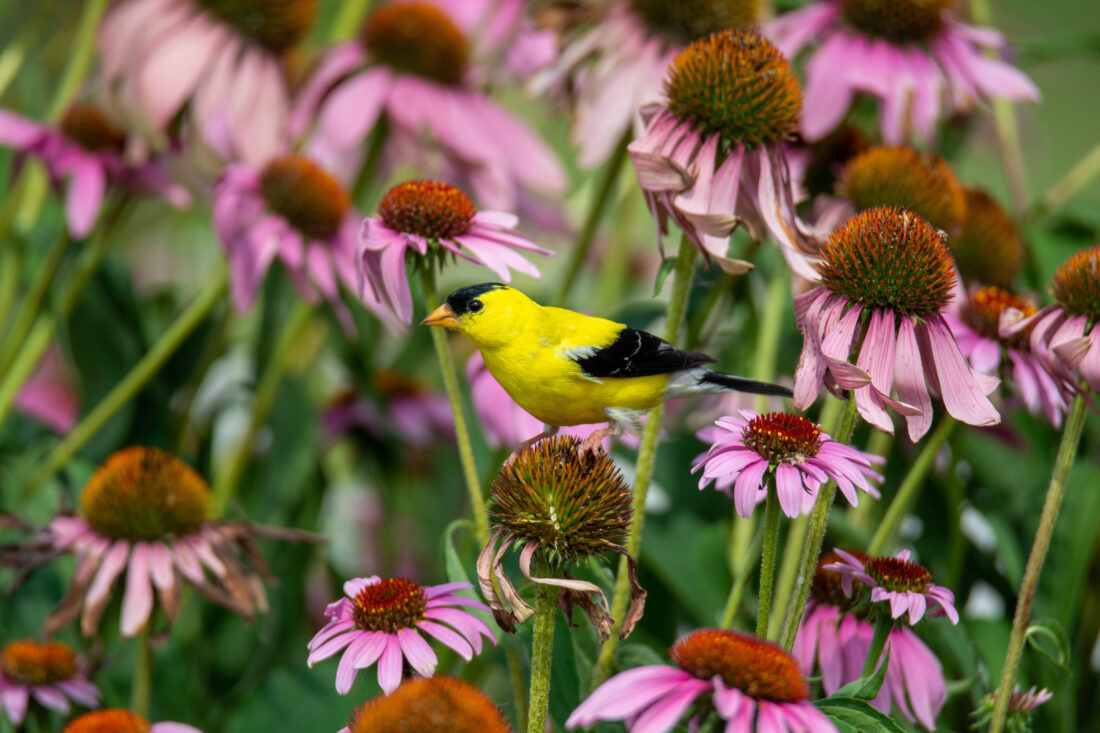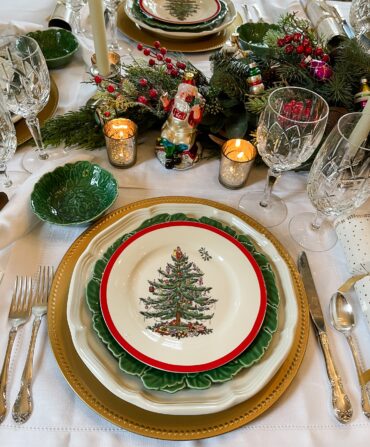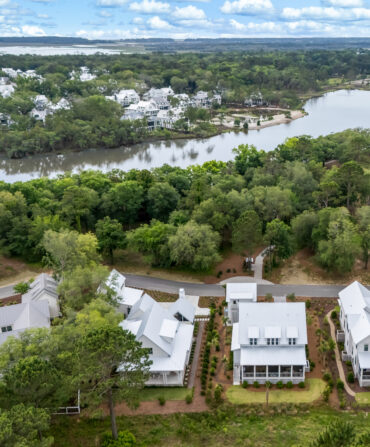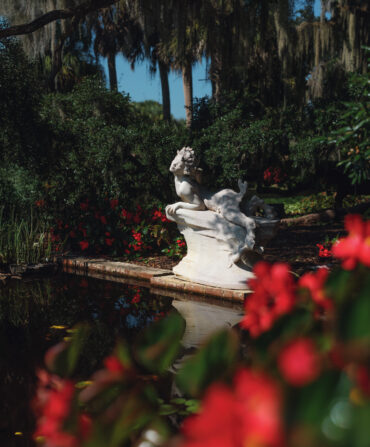My love for birding sparked my love for gardening. I’ve been spending my late winter mornings by the window, listening to chickadees, yellow-rumped warblers, and cardinals chatter from the water oak branches above my porch, where my potted coral honeysuckle has transformed from a dry, brown, gnarled mess to a cloud of tender green leaves—on its way to putting out trumpet-shaped orange blooms. Bird watching reminds me of the joy and song that persists in the natural world, despite everything. It’s no wonder two of my favorite authors, Margaret Renkl and Mary Oliver, find poetry in the curious creatures that visit their gardens.
I’ve been on a mission to create a bird oasis in my urban home. Avian species have especially suffered in the past few decades: On account of habitat loss and alteration, the world is now home to three billion fewer birds than it was in 1970, according to Jennifer McCarthey Tyrrell, the engagement manager for Audubon South Carolina. With the help of the Marsh Project, a grassroots organization focused on revitalizing Lowcountry marshland, and its most recent class on habitat gardening, I’ve collected seeds of native plants, including swamp sunflower, milkweed, phlox, and bee balm, for spring planting in hopes of restoring a bit of wildness to my pocket of green. “The moment you introduce a native plant to your soil, you’re making a substantial contribution to biodiversity,” says Blake Suárez, a co-founder of the Marsh Project.
When Suárez first spotted a painted bunting among the native plants in his own backyard in downtown Charleston, South Carolina, he thought he had imagined it; hard to miss with its vibrant, prismatic feathers, the species is a rare sight on the peninsula. In 2020, after reading Nature’s Best Hope by Douglas W. Tallamy, Suárez decided to do his part in his own slice of natural habitat. With the help of Roots and Shoots and Native Plants to the People, he reintroduced Lowcountry species like river oats, swamp mallow, and rattlesnake master. “We were looking to surround our children with nature, and the change we saw was almost instantaneous,” he says. He began to record monarch, io moth, red-humped, and Carolina sphinx caterpillars crawling around while tricolored bumble bees, blue-winged wasps, and red-banded leafhoppers flitted through the garden. And, of course, there were the birds: “Within a few weeks of finalizing the first planting of the backyard, we spotted three bird species new to our yard, including a red-winged blackbird, a hermit thrush, and a pair of Mississippi kites that decided to start nesting in our sweetgum.”
Below, Suárez and Tyrrell share a few gardening tips and native Southeastern species for birders hoping to create an avian haven.
Feeding the Birds
“If you look at different birds, you may notice their beaks are shaped a little differently, and those different shapes help them eat specific kinds of foods,” Tyrrell says. The slender, long beaks of hummingbirds dip into flowers to drink nectar. The pointed, large beaks of buntings and sparrows crack open small flower and grass seeds. Migratory birds fuel their journeys with berries, nuts, and seeds, while the sharp beaks of Eastern bluebirds, cardinals, chickadees, and wrens snap down on insects. Nearly all birds, however, need insects—especially caterpillars—to feed their young. Reintroducing native plants into your yard is one of the biggest keys to creating a thriving habitat for larvae and pollinators.
Alongside native plants, setting out a variety of food in feeders will bring in the birds. Orioles and tanagers will flock for jelly and oranges; bluebirds and warblers love dried mealworms; and chickadees, titmice, and finches will devour seed mixes. And don’t forget water sources: Thirsty birds and those looking to cool off will rejoice in a fountain or a standing bath with a solar-powered pump. (I love this one. I pour out my water, spray down the surface of the bath, and refill the water every three days to ward off mosquitoes and clear out leafy debris.) To my own delight, I nurtured my bird oasis enough to bring in a mystical, far-from-home Western tanager.
Bring in Berries
American beautyberry (Callicarpa americana)
Attracts: wood warblers (like black-throated blue warblers), American redstarts, Carolina wrens, orchard orioles, gray catbirds, tanagers
With graceful bending branches and clusters of bright purple fruit, this perennial shrub thrives across the South and grows up to six feet tall. Small pink flowers draw in pollinators in the spring, giving way to berries in the late summer to fall. The fruit attracts hungry migrating birds, including tiny black-throated blue warblers, which venture along the East Coast and winter in the Caribbean islands and Central America. The males, which are white with dark blue backs and black masks, are easy to identify and have a relaxed song that rises at the very end—some birders think it sounds like “I’m so lazzzzzzy.”
Red mulberry (Callicarpa americana)
Attracts: American goldfinches, Baltimore orioles, cedar waxwings, indigo buntings, Eastern bluebirds, Eastern towhees, purple finches, blue jays
This adaptable tree thrives across the region and in many different light conditions. It’s a fixture in the ecosystem: Mourning cloak moth caterpillars feed on the leaves, and an array of birds gobble the dark berries (a study in Arkansas recorded over thirty-one different species of bird in one tree over the course of three days). Humans love it too, jarring the bright red berry for desserts, jams, and juice.
Downy serviceberry (Amelanchier arborea)
Attracts: cedar waxwings, Baltimore orioles, American robins, catbirds, brown thrashers, Northern mockingbirds, red-bellied woodpeckers, red-eyed vireos
These small trees are some of the first to flower in the spring, pushing out clouds of feathery blooms that can be white, pink, or yellow. After the short show of flowers, knots of dark berries droop from the branches and ripen in June and July. The blueberry-like fruit has an earthy sweetness and can be foraged for juicy cocktails, jams, and pies.
Stock Up on Seeds
Coneflowers (echinacea)
Attracts: American goldfinches, chickadees, pine siskins, blue jays, dark-eyed juncos
Named after the Greek word echînos, meaning hedgehog or sea urchin, this leggy perennial plant boasts large orange-brown flower heads brimming with seeds. Its stems can grow up to four feet tall, and the thin, usually purple petals curve downward, inviting the admiration of both gardeners and birds. Goldfinches and chickadees perch atop the heads and forage for seeds, and ruby-throated hummingbirds will drink nectar from the tiny yellow florets that bloom from the flower head.
Swamp sunflower (Helianthus angustifolius)
Attracts: Song sparrows, Eastern towhees, blue grosbeaks, indigo buntings, tufted titmice
The swamp sunflower is a favorite of Tyrell for gardeners looking to draw in wildlife. “The wintering birds love their seeds,” she says. These easy-to-care-for, leggy plants turn into swaths of bright yellow in mid- to late fall, and they tolerate many different types of soil. The caterpillars of silvery checkerspots, painted ladies, bordered patches, and gorgone checkerspot butterflies use the swamp sunflower as a host plant, and it also attracts leafcutter and longhorn bees.
Rattlesnake master (Eryngium yuccifolium)
Attracts: cardinals, grosbeaks, wrens, sparrows, thrushes, orioles, finches
With spiny hemispherical heads that jut out on skinny stems, rattlesnake master flowers look like thistles, but they’re actually a member of the carrot family. Skipper butterflies, monarchs, beetles, and wasps hang around the flowers to collect nectar and pollen, and finches and other seed-eating birds descend on dried seed heads.
Nurture Nectar Collectors
Coral honeysuckle (Lonicera sempervirens)
Attracts: Ruby-throated hummingbirds, purple finches, hermit thrushes, American robins
This climbing vine is quick to grow and a stunning showstopper once the tiny halos of green circular buds burgeon into long, slender red flowers. The trumpet-shaped blooms will add color to a garden for months, blooming in mid-spring and in bursts until late summer. Ruby-throated hummingbirds drink nectar from the flowers, and berry-eating birds will eat the bright red fruit from the vines in the fall.
Salvia
Attracts: Ruby-throated hummingbirds
Also known as sage, salvia is a tall, quick-growing flower that does well in hot and dry climates. Salvia is a member of the mint family; if you pluck one of the fuzzy leaves and rub it between your fingers, you can pick up the herbal smell. There are lots of different varieties, so make sure you’re selecting one native to your region—Salvia lyrata (lyreleaf sage), Salvia coccinea (scarlet sage), and Salvia azurea (blue sage) are found throughout the Southeast. The plants are a favorite of hummingbirds, who flit around the blooms to collect nectar.
A Naturalist Approach to Gardening
Think twice before cutting down that dead tree way back in your yard, trimming off dried-out coneflower heads, or scraping away fallen leaf litter. All of these naturally occurring processes of decay are actually beneficial to fauna, especially birds looking for food and shelter. Here are four tips that will help out the birds in your garden:
Set Up Shelter
“When it comes to dead trees, safety first. If it’s a dead tree that won’t crush your house if it falls, it becomes a free bird house and bird feeder,” Tyrell says. “For a long time, people thought dead trees and branches were ugly and bad, which led to many of those dead snags being removed.” The loss of dead trees brought about a catastrophic decline of Eastern bluebirds in the early twentieth century, though they’ve rebounded thanks to some help from bluebird-specific houses.
Dead trees are a source of life for insects and birds like chickadees, wrens, warblers, and woodpeckers. Pileated and downy woodpeckers drill into the decaying wood to carve out nests and store food, and they will embed hundreds of acorns into the bark, creating a winter stockpile known as an “acorn granary” to help sustain them in colder, less buggy months. Other species like Carolina wrens, screech owls, and tree swallows are secondary cavity nesters and depend on shelter in dead snags made by woodpeckers to raise their young.
As much as man-made birdhouses do help nesting birds, the size of the hole must be correct for certain species to protect them from European starlings or predators. “Project NestWatch is a great resource on using the right nest box for the right bird,” Tyrell says.
Leave the Leaves
Many moth, firefly, and butterfly species also depend on a moist, insulated blanket of leaf litter to survive through the winter as pupae. “If you remove all the leaves from your yard, you’re throwing away all the caterpillar eggs and larvae that all those baby birds need to eat in spring,” Tyrell says. Leave your fallen leaves, or scrape them into a pile to decompose and reuse as nutrient-rich compost later on.
Cut Back on Cutting Back
Where you might see dry, brown twigs and leaves, birds and insects see a hub of life. Even after their petals wither away, sunflowers and coneflowers become seed-dense buffets for finches, sparrows, blackbirds, chickadees, titmice, towhees, cardinals, and woodpeckers, among others.
Put Away Pesticides
We have plenty of icky Southern bugs, including dreaded palmetto bugs and swarms of mosquitoes, that make us want to whip out the insect killer. But pesticides (including pyrethrins used by most mosquito spray companies) can’t single out specific species, and beneficial insects including bees, caterpillars, moths, and butterflies suffer—as do birds and other organisms in the greater food chain. Instead, consider setting up a “bucket of doom” mosquito trap that targets mosquito larvae.
Garden & Gun has affiliate partnerships and may receive a portion of sales when a reader clicks to buy a product. All products are independently selected by the G&G editorial team.








